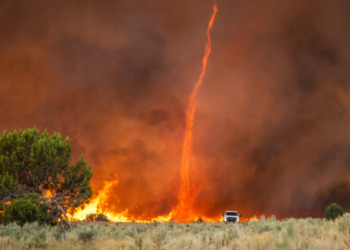The idea of rewilding, in simple terms, is letting nature run its course once again within areas of land that have been cultivated by human beings. This includes the reintroduction of species that have been driven away from the area by human activity or become locally extinct.
Different areas within nature can become interlinked and increase in size, starting at a core zone of a wild area and expanding to create smaller zones in the surrounding premises. This can be done with corridors such as hedges or fencing to reduce grazing and allow regeneration.
This allows animals to form new habitats as more land becomes available to them.

The benefits of rewilding
One of the main reasons the method of rewilding is being used, is because it’s one of the best ways to allow wildlife to adapt to climate change as well as increase the biodiversity of the areas where it’s implemented.
If areas of land that may have previously been used for grazing are allowed to rewild and have plants grow all over, the rewilded area can then help to soak up large amounts of carbon and absorb water via the plants’ roots to prevent floods from happening.
Plants allow water to filter into the ground rather than just sitting on the surface, and they can also temporarily store rainwater in their leaves, allowing water to evaporate from the leaf surface before it has the opportunity to make its way to the ground.
With sobering figures today showing native plant species having plummeted in Britain in 20 yrs, we must learn from those who are managing to turn the tide!
Just last week @Wildkenhill shared news of the proliferation of plants thanks to rewilding. https://t.co/VmEXa37GKN https://t.co/nDWvkd0NGJ
— Rewilding Britain (@RewildingB) March 8, 2023
Much like fresh water and food security, biodiversity is essential for supporting humanity. For example, many commonly-used human medicines are plant-based.This is just one of the ways humanity’s existence could be jeopardized if the biodiversity of our planet continues to deplete. In saving plants and animals, we are saving ourselves in turn.
This is where rewilding can help, by reversing species extinction by reintroducing vital plant and endangered animal species back into the land.
Groups such as One Health by The World Health Organisation (WHO) recognize that the “health of humans, domestic and wild animals, plants, and the wider environment (including ecosystems) are closely linked and interdependent”
With this recognition, One Health is working towards understanding the full spectrum of disease control and therefore contribute to the advancements of global health security.
£1M spent with local suppliers
60 ha degraded peatland restored
15K sq m wetland created
9 km hedges planted
Otters at >½ sites
236K visitors
137 nature-related visitor events hosted
532 volunteers engagedhttps://t.co/w7ePWYwLPH
— Rewilding Britain (@RewildingB) March 7, 2023
The disadvantages of rewilding
One problem with the concept of rewilding is that, if misused, it can end up causing harm to the already existing biodiversity of the area.
An 2019 study looked at an example of this: The Oostvaardersplassen (OVP) project in the Netherlands; a project which started in 1983 and involved introducing Konik horses, Heck Cattle and red deer to reclaimed land.
The numbers of the animals being introduced were not sufficiently regulated, wildlife could not move to new habitats and because of the high populations, vegetation was reduced by overgrazing and caused 30% of the animals to die during winter due to food scarcity.
Controversies also contribute to some of the downfalls of rewilding.
So why is it so controversial?
The main reason that many people are strongly opposed to the idea of rewilding is because of its potential to hurt local enterprises, leaving them run dry of business and therefore profit. This is specifically an issue for enterprises which rely on fisheries, livestock, crop farming and hunting land.
But how does it hurt local businesses? Well, a sheep farmer can’t graze sheep and an arable farmer can’t grow crops in an area that is being rewilded. So they both risk losing their business.
However, if small areas on a sheep farm are rewilded, then the biodiversity will improve, resulting in better shade for sheep, better water courses and, through the natural dispersal of seeds, a healthier and broader diet for the sheep.
Projects aimed at reinstating natural habitats in areas that may have been purposefully modified by human beings for the sake of survival in the modern world, for example, running a business, need to be met with agreement on both sides of the coin.
Related Articles: ‘Nature is Our Ship. We Must Ensure it Stays Afloat’: Historic Biodiversity Deal Agreed at COP15 | ‘Right Wing Backlash’ Against Rewilding: David Attenborough’s Documentary Cut Short | David Attenborough’s Witness Statement: ‘A Life On Our Planet’
Professor of Forestry at Bangor University, Mark Rayment, has told Impakter some of the issues relating to the controversy between different parties involved in the rewilding sector.
“The reason that rewilding is controversial is that the term is ill-defined and means different things to different people,” says Rayment, which can lead to arguments and misunderstandings on the matter.
“Some people start from farming as their baseline, seeing rewilding as a loss of agricultural production; a priority over any gains in ecosystem function,” states Rayment.
Others see an unmanaged (natural) system as the baseline, in which case, loss of ecosystem function is more significant than gains in (food) production.
Neither constituency is going to accept that their gain is equal to their loss – they’ll always feel the loss greater, digging their heels in against the existential threat posed by the other.
“To some, just allowing hedgerows to grow a bit taller and wilder, and to leave the scruffy field corners uncultivated is rewilding because it allows more space for wild creatures to expand into. For others, nothing less than a complete cessation of anthropogenic activities is rewilding. Add a few of those people into a discussion and you have a recipe for controversy – one part stereotyping, one part demonizing, zero parts understanding the other perspective.”
– Mark Rayment, Professor of Forestry.
It can be hard to monetize sections of land that are subject to rewilding, which is where another problem lies, because people need money to survive. But as mentioned, biodiversity is also essential for human existence, so something of a happy medium needs to be established.
In fact, one of the reasons that the final episode of David Attenborough’s “Wild Isles” will not be shown on BBC One is because it contains rewilding-related content, showing that it truly is a sensitive matter that should be taken seriously.
Another controversial subject associated with rewilding is that it changes the visual aesthetics of a landscape.
In some instances, natural areas which are left to their own devices end up looking messy to the human eye; an array of thistles and nettles is not something most people find aesthetically pleasing.
Over time more interesting and aesthetic plant species may start to grow, such as pioneer tree species, but they will only establish themselves if there is an available bank of seeds already in the ground from a previous time period.
Pioneer species are species that are the first to “colonize” new habitats created by disturbance; barren environments which used to hold biodiversity but have since been affected by environmental changes.
If land has been ploughed, burnt by a forest fire or covered in pesticides it is rare that such seeds will be readily available in the ground as they will already have been destroyed.
What’s more, areas such as the Lake District or Somerset Levels in the UK are Areas of Outstanding Natural Beauty (AONB). They look as they do because the landscape is managed through farming. If rewilding is allowed, then these iconic, beautiful landscapes may change and some people are not in favour of this.
So what is the solution?
COP15 produced a historic outcome with 188 countries agreeing on a pact of international goals for the protection of biodiversity. The Kunming-Montreal Global Biodiversity Framework (GBF) is committed to addressing the ongoing loss of terrestrial and marine biodiversity.
The agreement of government action shows that rewilding is a legitimate form of protecting the planet and perhaps now this government correspondence has been established, a clearer meaning of the rewilding concept will be established too.
There are many arguments on both sides of the coin regarding whether rewilding is a concept that should be more widely introduced into society.
It would seem that for more implementation of rewilding to be established, there needs to be a higher level of education and awareness as to what rewilding really is, as the misunderstanding of meaning could be seen as the root of the problem.
Editor’s Note: The opinions expressed here by the authors are their own, not those of Impakter.com — In the Featured Photo: Wild plants on the forest floor. Featured Photo Credit: Maria Orlova










